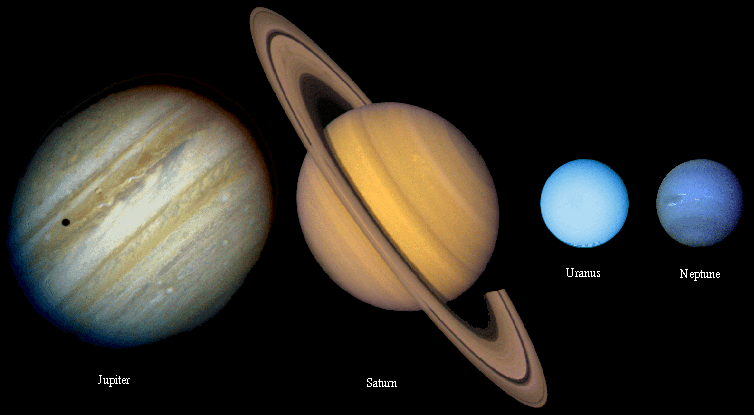
|
Topic 6: The Jovian Planets
Reading:
Chapter 8: Jovian Planet Systems
|
There is a clear distinction between the
Terrestrials, Jovians, Rock/Ice
planets in terms of their sizes, masses, and densities, compositions,
and placement in the Solar System.
Another difference is that
all of the Jovian planets have extensive satellite and
ring systems. On a deeper level, there is also a dichotomy in the
properties of the Jovian planets in that we have
Jupiter/Saturn versus Uranus/Neptune.
See Topic 4 for tables that lay out these differences in more
detailed terms.
The cause of the differences between Jupiter/Saturn
and Uranus/Neptune is probably due to the timing problem we
discussed earlier when we talked about the formation of the Solar System. The
reason Jupiter and Saturn are so massive and large is due to the fact that they
formed where water ice could exist and thus they were able to grow to large
masses rather quickly. Their large masses enabled them to capture the abundant
hydrogen and helium gas which explains their composition and their overly large
masses. Uranus and Neptune forming slightly farther out in the Solar Nebula,
also formed where water ice existed but everything happened more slowly. Before
they reached the point where they could capture significant amounts of hydrogen
and helium gas, the young Sun ignited became bright, and generated an
intense Solar Wind and cleared the gas out of the Solar Nebula which
halted the formation process of Uranus and Neptune not allowing them to reach
their full glories.
Such an event may also contribute to why the most
populous extra-Solar planets are mini-Neptunes and super-Earths, planet-types
found in our Solar System.
In this part of the course on Jovian planets, we concentrate on
a couple of issues. We consider issues involving the formation of the
Jovian planets and how some of their major moons,
Europa (Jupiter), Enceladus (Saturn), and
Titan (Saturn) fit into searches for life outside
the Earth. Our aims are two-fold:
(1) We return to our model for the formation of Jovian planets, the
core-accretion model. We describe the interiors
of the Jovian planets, Jupiter, Saturn, Uranus, and Neptune and then look at
recent observational results on Jupiter from Juno
and Saturn from Cassini
to see how comparisons of our models
for the interiors of Jupiter and Saturn fare when
compared to data. Such comparisons may show whether
the core-accretion model for
the formation of Jovian planets needs revision or if it is
still good to go.
The Cassini
observations were actually of the rings of Saturn. We look at the
properties of ring systems and how Cassini
was able to use the rings as
probes of the interior of Saturn.
(2) We look at the major moons of Jupiter and Saturn and their general
properties. In particular, we consider questions of whether
Europa and Enceladus
are good candidates for searches for LAWKI,
and if the Saturnian moon Titan,
the moon with the most massive
atmosphere, is also a good search candidate for LAWKI
.
The questions from Topic 2
bear on our notions of what constitutes
the Habitable zone of our Solar System and
other extra-Solar planetary systems.





